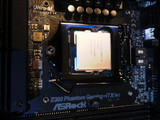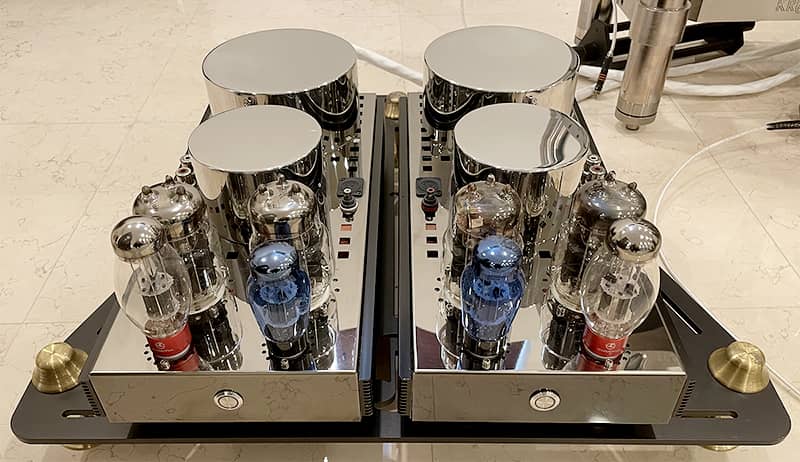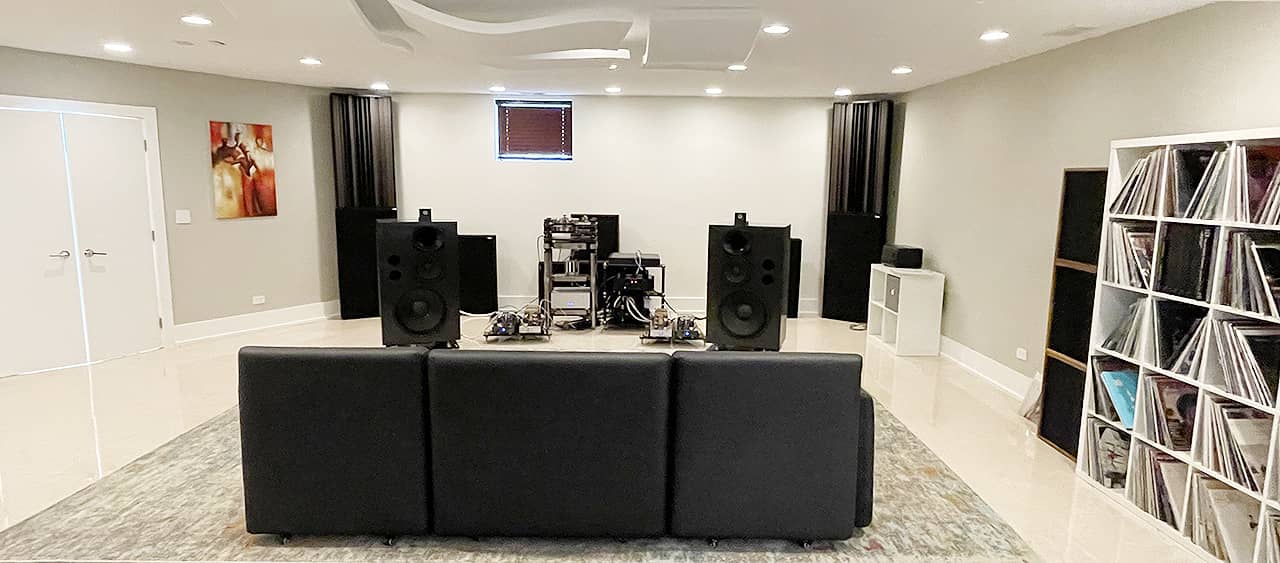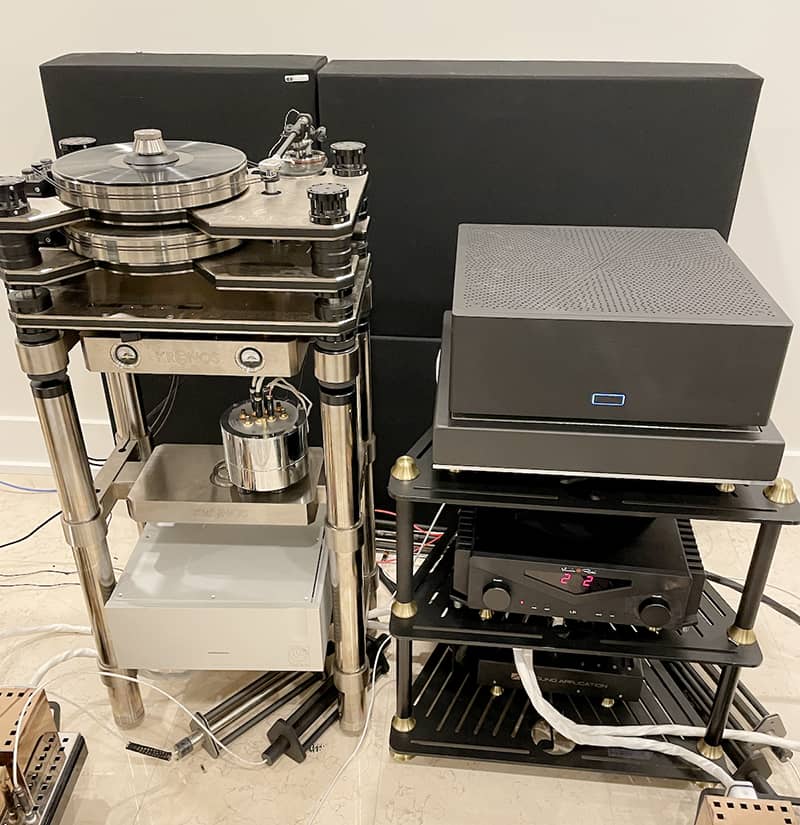Down The Rabbit Hole: Network Tweaks & Streamer DIY

Streaming music via the internet has evolved considerably over the last two decades. Talk about an understatement. By now, everyone has Spotify, and everyone's got access to everything. There are so many ways to get digital music to our ears, and thanks to Tidal and Qobuz it's also never been easier to pipe the world’s music in high-res to a high-end stereo.
But what's happening on the complicated end of the streaming scene, where audiophiles are pushing the limits of streamed fidelity? Despite the simplicity of modern HiFi streaming and, really, in the spirit of the audiophile hobby, I wanted to explore the “tweaky” side of the modern music medium and discuss some of the optimizations available. I recently just placed a Nordost QNet with a QSource LPS into my home network, and I absolutely love it, but I’m no IT specialist -- I'm just a restless audiophile tweaker.
So, for detailed information and a better perspective, I decided to reach out with a few questions to an acquaintance I met through my podcast* who happens to be an IT professional. He's also an audiophile, and he's DIYed everything you can imagine, from servers to speakers to amps to turntables.
I first got to know Vassil when he contacted me in response to a statement my podcast host and I had made on the show about the surprising length of break-in time required for an Innuos music streamer/server that we’d been evaluating. Vassil emailed to say that the power supply in the Innuos was designed by Dr. Sean Jacobs of Custom Hifi Cables Ltd. and contained über high-quality Mundorf capacitors which are well-known to require an extensive burn-in period.
This was my introduction to the cult following surrounding Sean Jacobs power supplies, which I now understand maintains a significant presence in the tweaky and DIY audiophile scene. And elsewhere, of course -- these aftermarket power supplies have tons of fans.
In talking with Vassil, I also heard about Taiko Audio's innovative methods for achieving the highest fidelity of streaming playback quality. While Innuos would build around the low-CPU-power philosophy and keep computations to a minimum (ostensibly, noise as well), Taiko’s approach went to the other extreme, finding better dynamics from over-speccing the processors and power supplies.
Vassil’s search for the best possible streaming signal chain led him to consider everything and develop his own ideas while experimenting with every possible variable. He forged a relationship with Dr. Jacobs through his DIY attempts to use Jacobs’ linear power supply circuits throughout his system. Later, Vassil became a remote builder for the DC4 linear power supply, helping Custom Hifi Cables Ltd. handle the demand for their products.
Of course, this open access to PCBs and parts was fuel to the fire of an audiophile DIYer like Vassil, and he eventually embarked on a project to build the best all-out-assault audio server he could. He documented every step on a forum thread, which has garnered much attention and generated tons of discussion.
Now, fair warning -- this is a big thread that may funnel time from your life just as it fills your mind with esoteric information, information that may seem utterly useless to your friends and loved ones (such is the life of the hardcore audiophile):
https://audiophilestyle.com/forums/topic/58164-building-a-diy-music-server/
With that context, enjoy the short interview with Vassil about streaming audio and how to optimize it.
*I’m cohost of The Hifi Podcast with Darren and Duncan, available anywhere podcasts are streamed
|
 |
Hey Vassil! Thanks to your well-documented, no-holds-barred DIY server build, you’ve got some serious cred in the DIY community. There's also your shiny quartet of tube monoblocks, your crazy 5 gauge cables and your multiple speaker builds displayed on Troels Graveson’s website. You've experimented with everything. In the AudiophileStyle thread you explain that you created the server for someone else. Was this your first attempt at making a streamer and server?
Thank you. You know how it is when you get to this hobby. You constantly want to improve your system, but you get quite a shock when you see the ridiculously high-end audio prices. A $5,000 component with parts that cost $300 inside? Isn’t that screaming for DIY?!
There are typically two reasons people turn to DIY for. Reason #1 - to get more performance from your hard-earned money. Reason #2 - to build something that does not exist on the market. My journey started with reason #1, and I built a roughly $5K phono stage with $300 of parts inside. But then I moved into reason #2 and wanted to make my digital rig sound as good as my analog rig.
After building the $300 ($5K MSRP) phono stage and building a Lenco turntable, some speakers, and a line stage, I started to wonder why computer audio can’t sound as good as analog. I think I had a NAD M51 DAC and a MAC mini at the time. I am an IT guy by profession, so it made sense to try combining DIY and computer technologies together. My mission was to make computer audio sound as good as analog.
First, I changed my DAC. I tried quite a few DACs. The two I liked at the time were the Ayre Codex followed by the Denafrips Terminator. At the same time, I started working on the streamer/computer feeding the DAC.
I started with a Raspberry Pi. Added an sBooster power supply - wow, that made a big difference! I immediately understood the importance of the power supply and acquired a bunch of other power supplies to experiment with - Acopian, Uptone Audio LPS-1.2, some Chinese modules, etc.
Then I started playing with network isolation. I bought one of these hospital-grade network isolators (Baaske Medical MI 1005 and another one from Emosystems). You put the network isolator between the Raspberry Pi and your router, and you hear an immediate improvement.
One of my local friends in Chicago had a Chinese CD player (the brand was Bada) modified by AudioMirror. This was my reference for quite some time. Every time I made progress with my digital, he would come with his Bada CD player, and we’d do an A/B comparison. As excited as I was, the Bada killed my Raspberry Pi :).
I was inspired by the Innuos products back then. I really liked their philosophy - start with a clean digital signal, so there is less to clean later. It made perfect sense. They used a low-powered CPU, which can be easily powered by a good LPS (Linear Power Supply). And they put a lot of effort into the LPS. I got the stock Supermicro motherboard they were using (minus their customizations). My first server prototype was built on the floor with point-to-point soldered parts using very similar hardware as the Innuos Zenith MK3, powered by the best LPS I had, which was a huge improvement over my Raspberry Pi.
I called my friend with the Bada CD player again, and for the first time, my digital source was getting close to his CD player. I figured that Innuos knew what they were doing and decided to contact Dr. Sean Jacobs to see if I could get a power supply of the quality Innuos uses. His custom-made power supplies were quite expensive for me, so I asked him if he would be willing to sell me some DIY modules of his power supply.
Sean was hesitant in the beginning, as he thought he would spend a lot of time hand-holding during my project, but I eventually convinced him, so I became his first DIY customer. Trying his power supply on the Raspberry Pi brought things to another level. Trying it on the Supermicro motherboard brought some magic I’ve never heard from digital.
I called my friend, and he was back with his CD player. Most of the tracks we compared sounded pretty good. Actually, many sounded better on my computer. But one track was impossible to surpass - Brian Bromberg’s “Come Together” from the album Wood. The bass through my computer was much harsher than what I heard on CD. That became my new reference level and took a long time and a lot of effort to beat. He brought that CD player many more times, and this track was better on his CD for another year or two.
This was just the beginning of my journey. Once I had access to multiple “rails” (individual DC voltage outputs) of Sean Jacobs’ LPS, I decided to leave the Innuos hardware on the side and start exploring on my own.
I bought some fanless computer chassis from Streacom and HDPlex, and I started experimenting with different motherboards and CPUs.
For some reason, overbuilt gaming motherboards sounded better to my ears. There is no surprise there, as they built them to handle overclocking, and they use thicker PCB traces and better power components.
I tried different CPUs - Intel Xeon, Intel Core i7, Intel Core i9, several AMD models, etc. Every motherboard and every CPU had a different sound signature. RAM modules also sounded different.
Then I went into software and CPU optimizations. I have experience in low latency networking and Linux kernel, and I really like a distribution called Audio Linux, but then Euphony became my favorite. I’ve tried many other operating systems and players - Windows 10, Windows LTSC, several Windows Server editions, MAC OS X, Roon ROCK, Roon, HQPlayer, Amarra, Audirvana, LMS, etc., just to name some.
I kept in touch with Sean Jacobs during all this time. At some point, he came up with a new version of his power supply (now known as DC4), which I tried and quite liked.
I decided to put my DIY modules up for sale. Several people contacted me about them, but eventually, I talked to a gentleman from NY State. He already had a one-rail high-current Sean Jacobs power supply and asked me if I could build him a music server with his power supplies plus the ones I have. This was perfect - a nearly cost-no-object server and power supply and an excellent experiment I can learn even more from. Plus, in the end, I’d sell my Sean Jacobs modules and get paid for the experiment. So, no, it wasn’t my first server, but it wasn’t my last either.
What role does a power supply play in the sound quality of a streamer or server?
Well, it’s the most important component… by far!
Tell us more about how you were involved with Dr. Sean Jacobs and building his power supplies.
I was Sean’s first DIY customer, trying a DIY version of his DC3 modules. I really liked his technology and was considering starting my own business building custom music servers with his technology. Innuos is using low current CPUs. I wanted to build high-current CPU servers as I found them to sound more dynamic. But that requires a massive, powerful linear power supply (LPS).
Being in IT, I also realized that server support will potentially kill any small business by draining its support resources. The idea evolved into building a massive, high-quality, high-current linear power supply with plenty of headroom to power 95W TDP or 125W TDP CPUs that can draw a lot more power. We needed something like a 40-amp (at least) LPS for that. I contacted Dr. Jacobs and asked him if he could design such a power supply. I had only one requirement – to be the best LPS on the market. Otherwise, I would not go for it. We started working on a prototype that took nearly a year to develop and evolve.
In the meantime, Sean announced his DC4 LPS. He got a bunch of pre-orders and was so busy that he could not spend any time on the next iteration of our high-current power supply prototype. I saw how busy he was and offered my help to help him clear his queue so we could go back to our prototype. He gladly accepted my offer of help, trained me to build his LPS to his standards, and we started working together.
In the meantime, Taiko Audio came up with a prototype of a DC-to-DC ATX with GaN-based regulators and 99%+ efficiency. I was lucky to be the first to try that, and I am glad I did. That thing and the new technology made my high-current LPS idea obsolete before it even saw the world. So, instead of starting a new business, I started building Sean’s power supplies for the North American market. I am a passionate DIY-er, so all the income from that was immediately invested back into more experiments!
A typical networking setup has at least one wall wart DC supply somewhere. Where do you think is the most critical position in a networking audio system to swap it for a linear power supply?
With digital components, I find the most benefit comes the closer to the DAC you are. Let’s say you have a cable modem —> Router —> Switch —> Server —> DAC. The server benefits the most from a high-quality LPS. The switch is next, followed by the router and finally the modem.
Can you explain your philosophy of what matters most in a network audio signal chain?
The digital source does not start with the server/streamer or the DAC. That’s a big misconception. It begins as far upstream as you have access to. And that is the Internet connection coming into your house and includes your cable modem, router, network switches, WiFi, and anything in between. Once you realize this and start taking care of everything between the Internet cable and the DAC, you see great results.
The server/streamer is the obvious thing. Your home laptop connected with a USB cable to the DAC is not optimal for a high-end audio system. A purpose-built server/streamer will be much better. Add proper network isolation, linear power supplies on your network devices, a good USB cable, take care of vibration isolation and do everything else that you will do with your audio system and the results become quite apparent.
I guess it’s fair to say that my philosophy is that the digital source starts from the Internet cable hand off to your house and ends with the DAC conversion to analog. This is a complex chain of components that interact with each other.
You’ve mentioned your explorations in using different DC umbilical cable designs for the linear power supplies, and this is an area of possible upgrade. Can you talk about how the various geometries you tried affected the sound?
Absolutely. As you know even better than I do, the major components of a cable design are conductor material, dialectic, cable geometry, shielding (if any), and connectors. They all matter, but I have a favorite wire that makes a much more significant difference than different geometries, specifically for DC umbilicals. It’s the 15.5 AWG Mundorf silver/gold wire. It’s expensive at $50+ per foot, but it has been the best performer for DC cables. And I have tried many - Gotham star-quad, Neotech 7N copper, Neotech silver, almost all Duelund wires, VHAudio, and many more. The star-quad geometry works well. But that’s until you try the Mundorf silver/gold wire. No matter what geometry you use, it is better than any other wires I’ve tried. At least that is my experience. The Mundorf silver/gold wire is in PTFE, but I like to put it in a cotton (or silk if you can find it) sleeve and twist it.
Here is an interesting post from someone who tried a DC umbilical cable like that.
I used to shield all my DC cables, but as my system got more resolving, I found the shielding to make the sound more restricted and less open. I like big soundstage - wide and deep. It’s easy to do one or the other but not both. Shielding of DC cables helps the soundstage to get deeper, but it takes from the width.
In my system, you can hear the difference between two identical cables, one with passive shielding and one without powering my cable modem! It’s quite a shocking experience for the “bits are bits” people and all the measurement-based objectivists.
But I must make a disclaimer here. And it’s related to generalization and synergy. While these are my findings so far, they may not be universal for every system. Synergy comes into play here, and some systems may benefit from other configurations. But all the feedback I have received about the Mundorf silver/gold wire has been exceptional, and I believe it to be a safe bet for most systems.
In terms of your own streaming, do you have a favorite streaming service, and why is it your favorite?
Qobuz and Tidal are my two choices. I made an A/B comparison some time ago and preferred Qobuz by a little, so Qobuz is what I use. But I would not put too much into that comparison and would be happy with either.
What is your opinion on streamed versus locally served files? Do you play back downloaded music in your system or focus on streaming optimization? Or both?
Local files always sounded better in my system. I believe that has something to do with the lower latency, but don’t ask me how that matters if each track is buffered in memory before streaming. Some things kept me awake many nights, and as an IT engineer, I just have no reasonable explanation. But I trust my ears, and I can clearly hear the difference. I buy the albums I like and put them in my local computer storage. This also helps support those musicians, so I don’t mind it at all.
What do you do in your system to deal with noise from the network? Some convert from ethernet to optical and back to ethernet to “galvanically isolate” the network signal. What do you think of this approach? Have you tried it, or do you do something different?
I have done quite a few things. First, the “gateway” that my Internet Service Provider (Xfinity) sends is pretty bad. That all-in-one device is trying to do too many things. It’s a cable modem, a router, a WiFi access point, a switch, a firewall, and a VoIP gateway, all in one device. If we apply my philosophy that the digital starts from the Internet handout in my house, and if we treat the network devices like audio components, wouldn’t it make sense to use “separates” as we do with audio components? That will be similar to replacing a receiver with DAC, preamp, and amp.
So, I ditched the all-in-one gateway and replaced it with a separate cable modem, a separate route, switch, and access point.
Xfinity has a list of supported cable modems. I tried a few, and I discovered that each had its own sound signature embedded in the sound. Again, don’t ask me to explain that… I am just reporting what I am hearing… and scratching my head.
I liked the Arris SB8200 cable modem, which I use now. One end of the cable modem connects to the coaxial Internet cable coming into my house. The other end connects to my router, Ubiquiti Edgerouter X SFP. One connection from the Ubiquiti goes to my heavily modified switch. Another connection goes to my WiFi access point.
I also ditched all the switching mode power supplies those devices had and replaced them with a single multi-rail Sean Jacobs LPS to feed all of them. Those wall warts usually inject back noise (typical for super cheap switching mode power supplies) into our mains that can easily affect the sound quality of our system. So, using a good LPS there improves our network devices and eliminates the pollution of the wall warts.
I use a single 3-rail LPS rather than 3 individual power supplies. I prefer that so I don’t mix and match different ground planes from different power supplies, different manufacturers, etc. It’s also fewer boxes, less clutter, and fewer power cords. Believe it or not, the power cord to the power supply makes a big difference. So does the fuse.
The last part of your question was about fiber isolation. I do use fiber isolation, but not in the traditional way.
Let’s call the network path from the cable modem to my server an “audio path .” In my case, the audio path is cable modem>router>switch>music server. Everything in that path makes a difference. Even different RJ45 cables sound different.
Going from copper to fiber makes quite a bit of a difference. I don’t necessarily like fiber in my audio path. It sounds a bit leaner than I want it, and it opens a new can of worms. Fiber optic cables connect via transceivers. I’ve tested about a dozen different transceivers, and each had its own sound signature. You also have multi-mode fiber and single-mode fiber. One can go nuts with that stuff!
I have a different approach. I use fiber to isolate my home network from the audio path, keeping my audio path as clean as possible. The Ubiquiti router I have picked has one fiber port. I use it to connect my WiFi access (and the rest of my home network) via fiber. This “isolates” the noise of my home network from the audio path.
I am a network engineer and a network architect, and I do other things like VLAN isolation and other tweaks that help, but that might be too much for your readers to digest, so I’ll stop here.
Thanks for chatting about streaming with us, Vassil. Do you have any advice to give DIYers out there who want to try to build their own streamer or server?
First, there is a lot of info and many experiments documented in the audiophilestyle thread about my server project. It’s a big thread with over 150 pages, but it’s probably worth spending a weekend to read through if you are serious about this. It may save many trials and errors that other people have done and shared.
Second, be open-minded and test different things. You never know what you will discover.
And third, start with the best power supply you can get. I have posted the schematics and parts list of two versions of an unregulated linear power supply that is excellent for the Taiko ATX. You can’t go wrong with that. It’s free for DIY if you are comfortable building one. If not, Sean Jacobs offers a completed unit.


